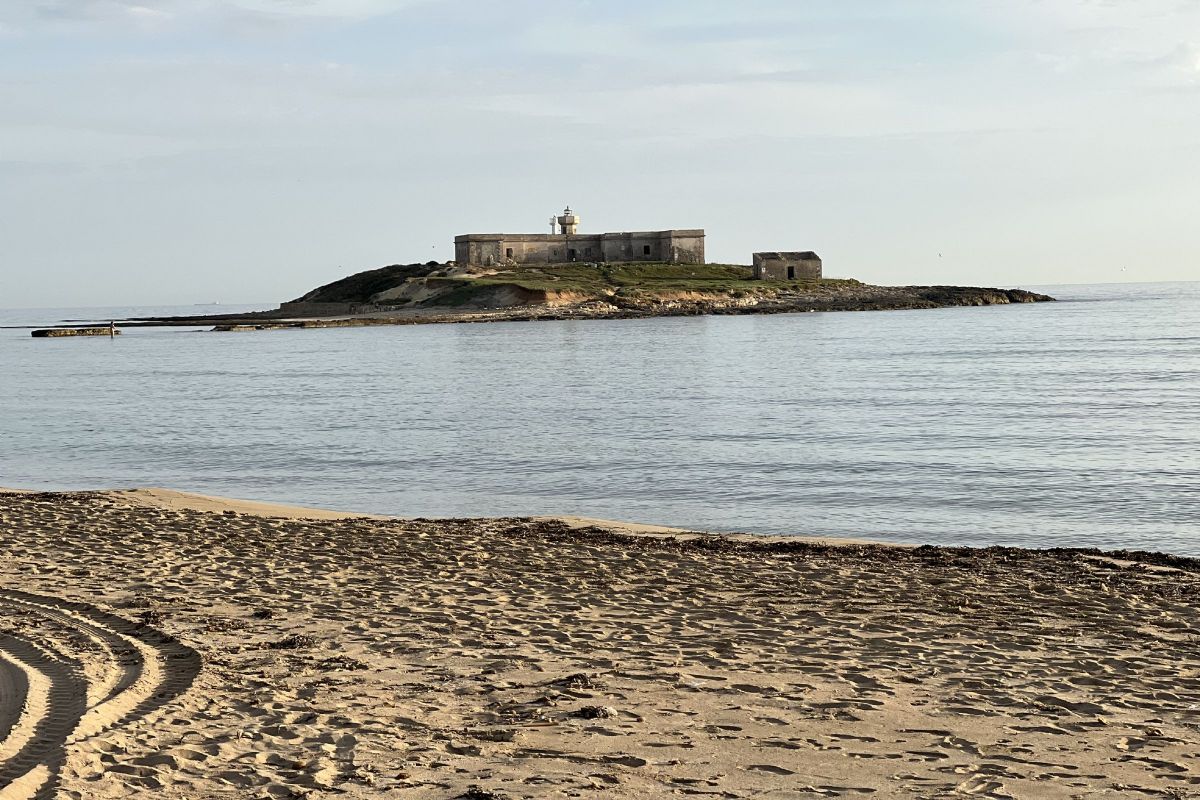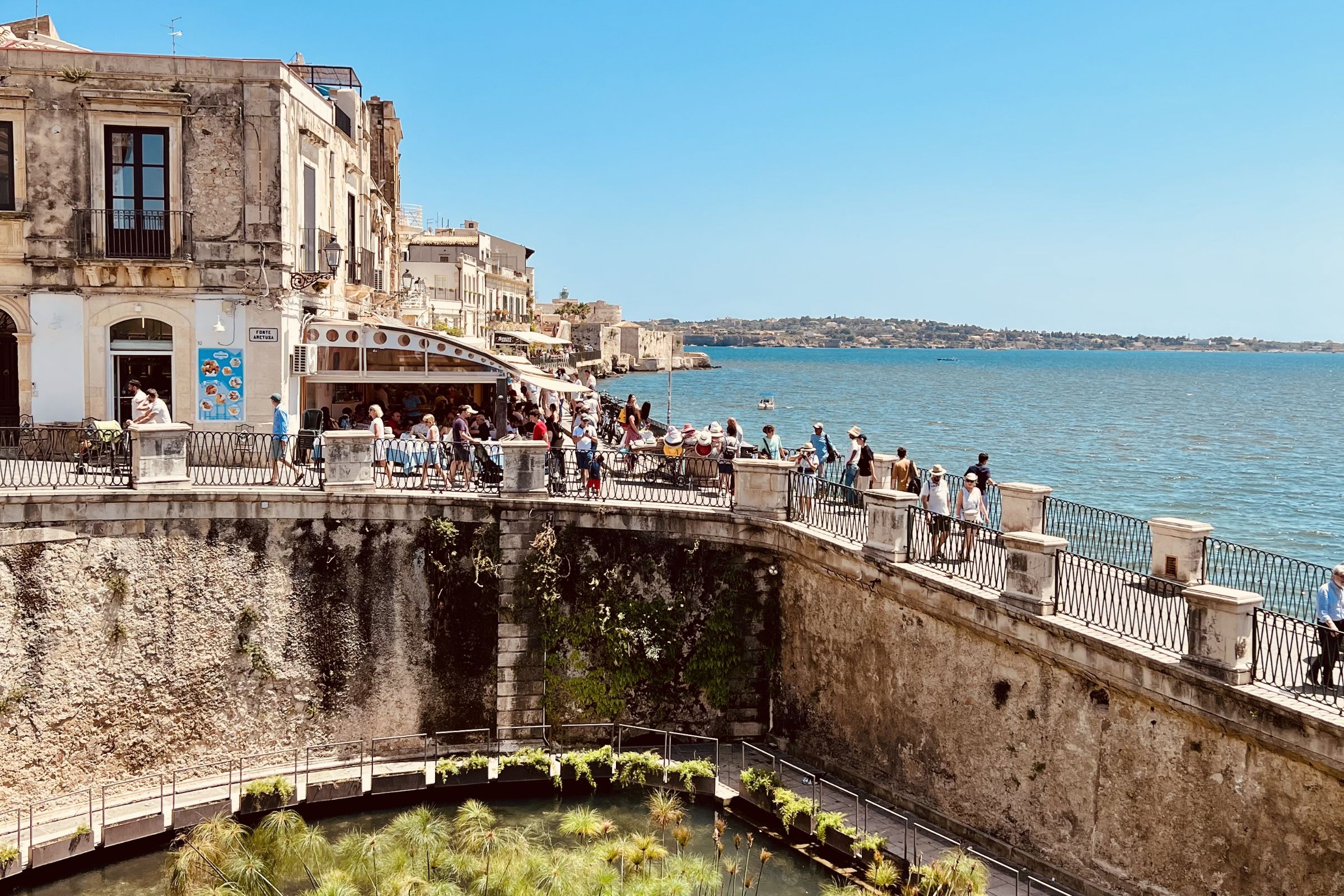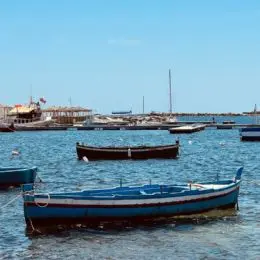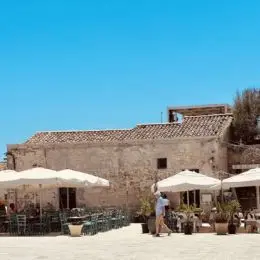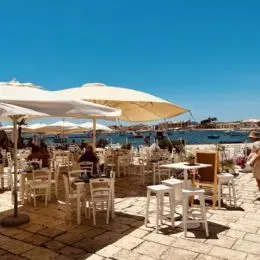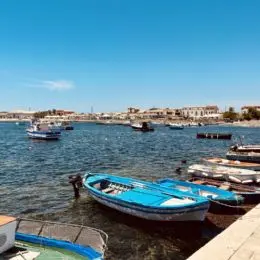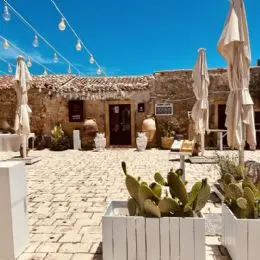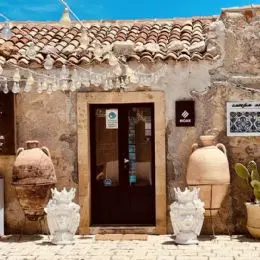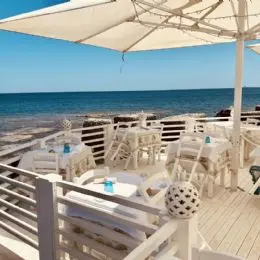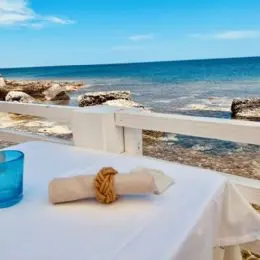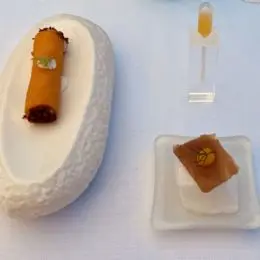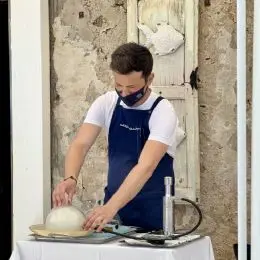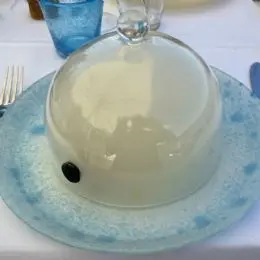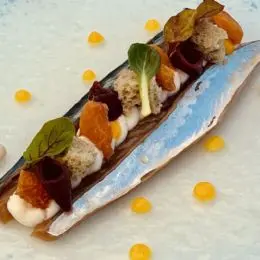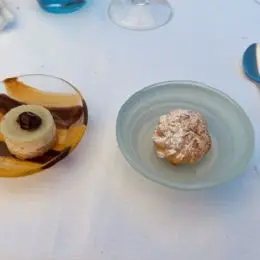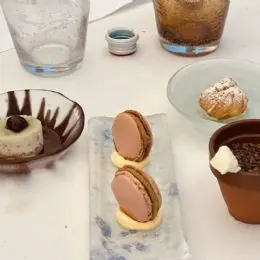Syracuse
Thanks to its compact and rather regular plan, Syracuse does not present particular difficulties for the visitor from the point of view of orientation.
The main places of tourist interest are concentrated in two areas: the island of Ortigia and the Archaeological Park of Neapolis , located on the opposite side of the city about 2 km away. The railway station is located west of Corso Gelone, the busiest commercial artery in the city. Reaching Ortigia on foot takes between 15 and 20 minutes.
The historical events of Syracuse are of fundamental importance not only for the history of the island but also for that of the entire Mediterranean basin, and in ancient times its influence and power were superior to those of any other Sicilian city .
Syracuse reached its apogee in the classical era, a period to which its most beautiful monuments date back, and imposed its supremacy over all the other cities of the island for more than 500 years, becoming in the period of maximum flowering, when the population was three times the current one, the largest power in Europe .
The central position of its port along the main trade routes ensured that the city continued to exert its influence and maintain its prestige even after its heyday.
All this is reflected in an astonishing variety of monuments, spanning the Hellenistic, Early Christian, Medieval, Renaissance, and Baroque periods. Syracuse is one of the most pleasant and interesting Sicilian cities, with a suggestive and fascinating historical center and archaeological and leisure areas that can easily take 3 or 4 days, if not a week.
Inserted in 2005 by Unesco in the list of World Heritage sites , Syracuse still retains the same structure of two and a half millennia ago, being divided between the ancient center, the island of Ortigia , and the four districts on the mainland: Acradina , Tyche, Neapolis and Epipoli .
Ortigia, a predominantly medieval and Baroque ensemble of stately homes and palaces, is still the heart and soul of Syracuse and contains most of the best hotels, cafes and restaurants in the city. At the opposite end of the New Bridge, the main bridge that connects the island with the mainland, the modern city stretches, its center is the Acradina district , which today, as in the Greek age, is the hub of commercial activities and it is crossed by a large artery, Corso Gelone.
To the north of Acradina, the ancient residential district of Tyche is home to the famous Archaeological Museum and the extraordinary catacombs of Santa Lucia and San Giovanni. Neapolis is the site of the Archaeological Park which contains the ruins of the city's Greek theaters and some vast stone quarries. Syracuse offers pleasant half-day excursions outside the center. Stretched out on the western side of the city, Epipoli also houses the defensive walls and the remarkable remains of the Eurilao Castle . Other excursions outside the city can have as their destination the local beaches, especially that of the Fontane Bianche , or a cruise on the Ciane river.
What to see in Syracuse, Ortigia
The island of Ortigia, the physical and spiritual heart of the city, is an open-air museum in which the architectural testimonies of the Greek era are combined in harmonious symmetry with the Norman, Aragonese and Baroque ones.
The island is accessed via the Ponte Nuovo and the inner harbor with boats swinging lazily on the water and along which a row of rust-colored Venetian buildings line up. In recent years Ortigia has been the subject of important restoration works which have brought it back to its original splendor; it was also freed from car traffic.
Piazza del Duomo
Despite the predominantly baroque lines, the Greek origins of Syracuse stand out everywhere, even if hidden among more recent buildings. Nor is Piazza del Duomo an obvious example, the ancient acropolis of the Greek city, today surrounded by Baroque palaces built after the earthquake of 1693. Upon entering the square, visitors' attention is immediately drawn to the superb facade of the cathedral, a triumph of Baroque. Sicilian made by Andrea Palma.
Outside as inside are the remains of a Doric temple dedicated to Athena and dating back to the 5th century BC whose columns worn by time still support the roof of the building, even more extraordinary is the presence of the area built by the Sicilians three centuries earlier, one of the very rare traces of the first inhabitants of the island that has come down to us.
In ancient times the temple of Athena was known throughout the Mediterranean thanks above all to the writings of Cicero who visited Ortigia in the first century BC. Thanks to him we know that the doors were decorated with inlays in gold and ivory, while the interior was decorated with magnificent paintings depicting Agatocles, fighting against the Carthaginians.
To the north of the Cathedral is the Palazzo Municipale or Senatoriale, built in 1629. Recent excavations under the building have brought to light the remains of an Ionic temple whose construction seems to have never been completed and known as the "bed of Artemis" , the goddess to whom Ortigia was consecrated.
Arethusa Fountain
Immediately south of Piazza del Duomo is the Arethusa Fountain , a freshwater spring that has gushed from this point since ancient times when it was the main water reserve of the city. According to mythology, the goddess Artemis transformed the beautiful nymph Arethusa, her handmaid, into spring water, to protect her from the unwanted gallant approaches of the river god Alpheus. Under these guises, Arethusa fled from Arcadia and crossed the sea chased by Alfeo, who in turn turned into a river.
But when Arethusa re-emerged to the surface on the island of Ortigia, its waters mingled forever with those of the pursuer Alfeo. Today populated by ducks, mullets and papyrus plants, this source has become the obligatory destination for walks during the warm summer evenings.
Regional Museum of Medieval and Modern Art
Housed in the most beautiful Gothic-Catalan palace in Ortigia, the thirteenth-century Palazzo Bellomo , the Regional Museum of Medieval and Modern Art exhibits a remarkable collection of sculptures and paintings ranging from the Middle Ages to the twentieth century. Among the most significant works are the Byzantine icons, and Spanish paintings and a number of quite impressive religious paintings, among which "The massacre of the innocents" stands out for its crude realism.
Archimedes Square
A walk in the intricate maze of alleys of Ortigia is a unique and fascinating experience. Right in the center of the island is the beautiful Piazza Archimede with the nineteenth-century fountain by Giulio Moschetti depicting Artemis, goddess of the hunt, surrounded by a crowd of maids and mermaids.
This square, considered the "living room" of Syracuse, is framed by buildings in the Gothic-Catalan style, including Palazzo Lanza and Palazzo Platamone.
Small Puppet Theater
In the Jewish quarter there is the Piccolo Palazzo dei Pupi of Syracuse run by the friendly Mauceri brothers.
Other things to see ...
At the entrance to Ortigia are the remains of the Temple of Apollo , one of the oldest buildings built by the first Greek colonists on the island. On the southern tip of the island stands the silhouette of the Maniace Castle , built in the thirteenth century by Frederick II as part of an ambitious project that aimed to make Ortigia an entirely fortified island.
What to see in Syracuse, the mainland
Acradina
Bombed twice during the Second World War, the Acradina district shows for the most part the unmistakable imprint of post-war reconstruction. Near Piazzale Marconi you can see the ancient Syracusan Forum, once the site of the agora and today crossed by a series of very busy streets.
A few hundred meters west of the forum, in via Eloria, are the evocative ruins of the Roman gymnasium, dating back to the 1st century AD. large atrium and another theater that opens directly behind the stage.
On the seafront, east of the forum, there are the completely fenced ruins of the ancient arsenal, next to it you can see the remains of the thermal building from the Byzantine era where, it is said, the Emperor Constant II in 668 was assassinated with a soap dish. To the north of the arsenal opens Piazza Santa Lucia , one of the largest in the city, whose northern side is dominated by the Church of Santa Lucia al Sepolcro .
Tyche Catacombs
According to Roman law, Christians were prohibited from burying their dead within the city limits. Forced to leave the urban territory, the Christians chose the present-day district of Tyche as their burial place, and more precisely an underground aqueduct that had remained unused since the times of the Greeks.
New galleries were built in order to create a labyrinth of passages and burial chambers, today mostly not accessible to the public, with the exception of those below the Basilica of San Giovanni .
The catacombs are largely dark, humid and somewhat spooky. Thousands of small niches are dug along the walls of the galleries that lead from the main room to the rotundas, circular spaces where the faithful stopped to pray.
Over the centuries, grave robbers have taken away all the precious objects buried with the deceased, with the sole exception of a sarcophagus found in 1872 and now exhibited in the Paolo Orsi Archaeological Museum .
Paoli Orsi Archaeological Museum
At the end of Viale Cadorna is the largest Sicilian archaeological museum, the Paolo Orsi Archaeological Museum. The museum is located in the property of Villa Landonia and is named after the archaeologist Paolo Orsi who, having arrived in Sicily in 1886, dedicated the remains of his life to the discovery of the ancient treasures of the island.
The collection is very consistent and well organized and is wheelchair accessible . The large atrium in the center of the building acts as a reference point and is equipped to offer all the information necessary for visiting the three sectors into which the museum is divided. The collection covers a period ranging from prehistoric times to the first Greek settlements.
The collection of sculptures is noteworthy: they range from the archaic finds of Magara Hyblaea among which the statue of a mother nursing her twins, to the Roman period, with the representation of Venus Anadiomedes also known as Venus Landolina.
Among the other masterpieces we note the delicate votive terracotta offered to Demeter and found during the works for the construction of the Sanctuary of the Madonnina delle Lacrime , in addition to the famous terracotta depicting the grotesque face of the Gorgon with Pegasus.
Papyrus Museum : exhibits a collection of documents and objects made with papyrus, this plant was used until the eighteenth century to prepare paper, it still grows luxuriantly near Syracuse on the banks of the river Ciane.
Archaeological Park of Neapolis : from the papyrus museum, continuing about 500 m towards the west, you will find the entrance to the large Archaeological Park of Neapolis, the most popular tourist destination in Syracuse. The fame of this site certainly lives up to expectations given the spectacular nature of the impressive open-air quarries, the grandiose theater and the fascinating and romantic decay of its ruins.
Latomia of Paradise
From the north you enter Latomia del Paradiso, an ancient and immense limestone quarry full of caverns and caves and dotted with olive and orange trees. In Greek times the quarries were covered by a clay vault which collapsed during the earthquake of 1693.
It was then that orange and olive groves were planted in the caves that were uncovered in the sunlight. The Greeks managed the quarries a bit like a concentration camp, using mainly prisoners of war to cut and extract the limestone blocks from the underground tunnels.
Within this area is the Orecchio di Dionisio , an artificial cave in the shape of an ear with extraordinary acoustic properties. Next to it is the cave of the Cordari supported by columns once used as a laboratory for the manufacture of ropes.
A tunnel connects the Latomia del Paradiso to the Latomia Intagliatella while a rocky path continues towards the Latomia di Santa Venera. Reaching the highest point of the site you can visit the Necropolis of Grotticelli , tombs from the Hellenistic and Byzantine periods.
Greek theatre
The main attraction of the Neapolis park is the white and shiny Greek Theater, entirely carved into the rock. The works of Sophocles and Euripides were represented, as well as the last tragedies of Aeschylus.
When the Romans occupied Syracuse in the third century, the structure of the theater was modified so as to be able to host gladiator fights and naumachiae (fake naval battles). Today the ancient stage comes back to life with the representation of classical theater works.
Roman amphitheater
In the southern area of Neapolis there is the Roman amphitheater of the 2nd century AD, the third in order of magnitude after the Colosseum and the Arena of Verona , where gladiator fights and equestrian races were organized.
Roman bettors parked their wagons in the area between the amphitheater and Viale Paolo Orsi. The Spaniards, little inclined to archeology, in the sixteenth century destroyed a large part of the site using the stones to build the walls of Ortigia.
Parties and events
Greek Theater Festival
Today Syracuse is the only city, besides Athens, to boast a classical theater school and its shows feature the greatest Italian actors. The performances take place between May and June.
Ortigia Festival
Festival dedicated to avant-garde and experimental theater, accompanied by musical events and art exhibitions, set in the scenography of Castello Maniace. It is held in September.
Feast of Saint Lucia
Every year on the occasion of this anniversary a procession takes place in commemoration of the patron saint of the city. The monumental silver statue of the saint is transported with great following along the streets of Syracuse, the procession is accompanied by fireworks.
Protected marine area of Plemmirio
The protected marine area of Plemmirio is not far from Syracuse and was established to protect the biodiversity of the sea mirror in front of the Maddalena Peninsula and Capo Murro di Porco , geologically along the axis of the Iblean-Maltese escarpment: a useful consideration to understand because this area offers the enthusiast and the scholar numerous biological surprises and wonderful backdrops.
From Capo Castelluccio to Punta Tavernara , the seabed remains low and uniform for several hundred meters, then suddenly drops to higher altitudes.
From Punta Tavernara to Capo Murro di Porco , on the other hand, already below the coast there are depths of over 30-40 meters. A series of submerged caves are home to solitary corals, sponges, sea cicadas, nudibranchs and many species of fish.
It is in Plemmirio that the largest shells of the Mediterranean live in depth, as well as colonial corals and some large groupers.
From Capo Murro di Porco annually observations of large pelagic fish such as tuna, amberjack, sharks and marine mammals such as dolphins, whales and sperm whales are held.
Among the other species of Mediterranean fauna present we mention the sparidae, the great wrasse, the serranidae. The seabed of the protected marine area of Plemmirio is very rich in important archaeological finds that can be traced back to the history of Syracuse, an important trade destination in the Mediterranean.
Finally, it should be noted that the Plemmirio Reserve is currently one of the few that is fully accessible to the disabled .
Marzamemi
Near Noto, in the province of Syracuse not far from Pachino, is Marzamemi an ancient town full of yellow stone houses located between two natural harbors. A jewel to visit if you want to discover hidden and typical corners of Eastern Sicily.
Marzamemi, Sicilian cuisine
Island of currents
The island of the Currents is a small island on the southernmost tip of Sicily located in the territory of the municipality of Portopalo.
